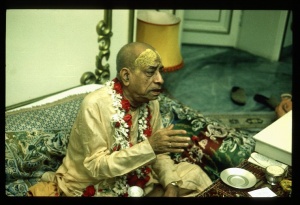SB 9.24.63-64: Difference between revisions
m (1 revision(s)) |
No edit summary |
||
| Line 1: | Line 1: | ||
{{info | {{info | ||
|speaker= | |speaker=Śukadeva Gosvāmī | ||
|listener=King | |listener=King Parīkṣit | ||
}} | }} | ||
[[Category:Srimad-Bhagavatam - Canto 09 Chapter 24]] | |||
[[Category:Bhagavatam Verses Spoken by Sukadeva Gosvami - Vanisource|092463]] | |||
<div style="float:left">'''[[Srimad-Bhagavatam]] - [[SB 9|Ninth Canto]] - [[SB 9.24: Krsna the Supreme Personality of Godhead|SB 9.24: Kṛṣṇa the Supreme Personality of Godhead]]'''</div> | |||
<div style="float:right">[[File:Go-previous.png|link=SB 9.24.62]] '''[[SB 9.24.62]] - [[SB 9.24.65]]''' [[File:Go-next.png|link=SB 9.24.65]]</div> | |||
{{RandomImage}} | |||
==== TEXTS 63-64 ==== | ==== TEXTS 63-64 ==== | ||
<div | <div class="verse"> | ||
bhoja-vṛṣṇy-andhaka-madhu- | :bhoja-vṛṣṇy-andhaka-madhu- | ||
śūrasena-daśārhakaiḥ | :śūrasena-daśārhakaiḥ | ||
ślāghanīyehitaḥ śaśvat | :ślāghanīyehitaḥ śaśvat | ||
kuru-sṛñjaya-pāṇḍubhiḥ | :kuru-sṛñjaya-pāṇḍubhiḥ | ||
snigdha-smitekṣitodārair | |||
vākyair vikrama-līlayā | :snigdha-smitekṣitodārair | ||
nṛlokaṁ ramayām āsa | :vākyair vikrama-līlayā | ||
mūrtyā sarvāṅga-ramyayā | :nṛlokaṁ ramayām āsa | ||
:mūrtyā sarvāṅga-ramyayā | |||
</div> | </div> | ||
| Line 21: | Line 27: | ||
==== SYNONYMS ==== | ==== SYNONYMS ==== | ||
<div | <div class="synonyms"> | ||
''bhoja''—assisted by the Bhoja dynasty; ''vṛṣṇi''—and by the Vṛṣṇis; ''andhaka''—and by the Andhakas; ''madhu''—and by the Madhus; ''śūrasena''—and by the Śūrasenas; ''daśārhakaiḥ''—and by the Daśārhakas; ''ślāghanīya''—by the praiseworthy; ''īhitaḥ''—endeavoring; ''śaśvat''—always; ''kuru-sṛñjaya-pāṇḍubhiḥ''—assisted by the Pāṇḍavas, Kurus and Sṛñjayas; ''snigdha''—affectionate; ''smita''—smiling; ''īkṣita''—being regarded as; ''udāraiḥ''—magnanimous; ''vākyaiḥ''—the instructions; ''vikrama-līlayā''—the pastimes of heroism; ''nṛ-lokam''—human society; ''ramayām āsa''—pleased; ''mūrtyā''—by His personal form; ''sarva-aṅga-ramyayā''—the form that pleases everyone by all parts of the body. | |||
</div> | </div> | ||
| Line 28: | Line 34: | ||
==== TRANSLATION ==== | ==== TRANSLATION ==== | ||
<div | <div class="translation"> | ||
Assisted by the descendants of Bhoja, Vṛṣṇi, Andhaka, Madhu, Śūrasena, Daśārha, Kuru, Sṛñjaya and Pāṇḍu, Lord Kṛṣṇa performed various activities. By His pleasing smiles, His affectionate behavior, His instructions and His uncommon pastimes like raising Govardhana Hill, the Lord, appearing in His transcendental body, pleased all of human society. | Assisted by the descendants of Bhoja, Vṛṣṇi, Andhaka, Madhu, Śūrasena, Daśārha, Kuru, Sṛñjaya and Pāṇḍu, Lord Kṛṣṇa performed various activities. By His pleasing smiles, His affectionate behavior, His instructions and His uncommon pastimes like raising Govardhana Hill, the Lord, appearing in His transcendental body, pleased all of human society. | ||
</div> | </div> | ||
| Line 35: | Line 41: | ||
==== PURPORT ==== | ==== PURPORT ==== | ||
<div | <div class="purport"> | ||
The words nṛlokaṁ ramayām āsa mūrtyā sarvāṅga-ramyayā are significant. Kṛṣṇa is the original form. Bhagavān, the Supreme Personality of Godhead, is therefore described here by the word mūrtyā. The word mūrti means "form." Kṛṣṇa, or God, is never impersonal; the impersonal feature is but a manifestation of His transcendental body (yasya prabhā prabhavato jagad-aṇḍa-koṭi ( | The words ''nṛlokaṁ ramayām āsa mūrtyā sarvāṅga-ramyayā'' are significant. Kṛṣṇa is the original form. Bhagavān, the Supreme Personality of Godhead, is therefore described here by the word ''mūrtyā''. The word ''mūrti'' means "form." Kṛṣṇa, or God, is never impersonal; the impersonal feature is but a manifestation of His transcendental body (''yasya prabhā prabhavato jagad-aṇḍa-koṭi'' (BS 5.40)). The Lord is ''narākṛti'', exactly resembling the form of a human being, but His form is different from ours. Therefore the word ''sarvāṅga-ramyayā'' informs us that every part of His body is pleasing for everyone to see. Apart from His smiling face, every part of His body—His hands, His legs, His chest—is pleasing to the devotees, who cannot at any time stop seeing the beautiful form of the Lord. | ||
</div> | </div> | ||
__NOTOC__ | |||
<div style="float:right; clear:both;">[[File:Go-previous.png|link=SB 9.24.62]] '''[[SB 9.24.62]] - [[SB 9.24.65]]''' [[File:Go-next.png|link=SB 9.24.65]]</div> | |||
__NOTOC__ | |||
__NOEDITSECTION__ | |||
Revision as of 12:52, 17 May 2021

A.C. Bhaktivedanta Swami Prabhupada
TEXTS 63-64
- bhoja-vṛṣṇy-andhaka-madhu-
- śūrasena-daśārhakaiḥ
- ślāghanīyehitaḥ śaśvat
- kuru-sṛñjaya-pāṇḍubhiḥ
- snigdha-smitekṣitodārair
- vākyair vikrama-līlayā
- nṛlokaṁ ramayām āsa
- mūrtyā sarvāṅga-ramyayā
SYNONYMS
bhoja—assisted by the Bhoja dynasty; vṛṣṇi—and by the Vṛṣṇis; andhaka—and by the Andhakas; madhu—and by the Madhus; śūrasena—and by the Śūrasenas; daśārhakaiḥ—and by the Daśārhakas; ślāghanīya—by the praiseworthy; īhitaḥ—endeavoring; śaśvat—always; kuru-sṛñjaya-pāṇḍubhiḥ—assisted by the Pāṇḍavas, Kurus and Sṛñjayas; snigdha—affectionate; smita—smiling; īkṣita—being regarded as; udāraiḥ—magnanimous; vākyaiḥ—the instructions; vikrama-līlayā—the pastimes of heroism; nṛ-lokam—human society; ramayām āsa—pleased; mūrtyā—by His personal form; sarva-aṅga-ramyayā—the form that pleases everyone by all parts of the body.
TRANSLATION
Assisted by the descendants of Bhoja, Vṛṣṇi, Andhaka, Madhu, Śūrasena, Daśārha, Kuru, Sṛñjaya and Pāṇḍu, Lord Kṛṣṇa performed various activities. By His pleasing smiles, His affectionate behavior, His instructions and His uncommon pastimes like raising Govardhana Hill, the Lord, appearing in His transcendental body, pleased all of human society.
PURPORT
The words nṛlokaṁ ramayām āsa mūrtyā sarvāṅga-ramyayā are significant. Kṛṣṇa is the original form. Bhagavān, the Supreme Personality of Godhead, is therefore described here by the word mūrtyā. The word mūrti means "form." Kṛṣṇa, or God, is never impersonal; the impersonal feature is but a manifestation of His transcendental body (yasya prabhā prabhavato jagad-aṇḍa-koṭi (BS 5.40)). The Lord is narākṛti, exactly resembling the form of a human being, but His form is different from ours. Therefore the word sarvāṅga-ramyayā informs us that every part of His body is pleasing for everyone to see. Apart from His smiling face, every part of His body—His hands, His legs, His chest—is pleasing to the devotees, who cannot at any time stop seeing the beautiful form of the Lord.